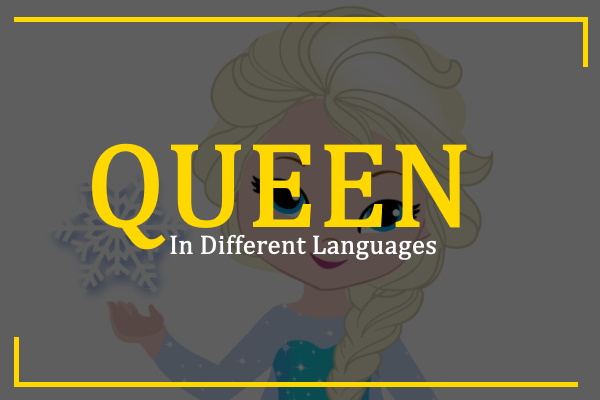Table of Contents
Queen in Different Languages
A queen is a female ruler who is married to a king and sit besides him. A Regnant Queen is a female sovereign which is equal in rank to a king who, in comparison to a reigning king’s wife, reigns in her own right and is the protector of a child monarch and reigns temporary in place of the child. We often call pretty girls as beautiful queen.
Here is the translation of word “Queen” in 10 other languages:
- English: queen
- Chinese: 女王
- Hindi: रानी
- Spanish: reina
- Arabic: ملكة
- French: reine
- Bengali: রাণী
- Russian: королева
- Portuguese: rainha
- Urdu: ملکہ
Queen in European Languages
| Different Languages | Word Queen |
|---|---|
| Albanian | mbretëreshë |
| Basque | erregina |
| Belarusian | каралева |
| Bosnian | kraljica |
| Bulgarian | кралица |
| Catalan | reina |
| Corsican | regina |
| Croatian | kraljica |
| Czech | královna |
| Danish | dronning |
| Dutch | koningin |
| Estonian | kuninganna |
| Finnish | kuningatar |
| French | reine |
| Frisian | keninginne |
| Galician | raíña |
| German | Königin |
| Greek | βασίλισσα [vasílissa] |
| Hungarian | királynő |
| Icelandic | Drottning |
| Irish | banríon |
| Italian | Regina |
| Latvian | karaliene |
| Lithuanian | karalienė |
| Luxembourgish | Kinnigin |
| Macedonian | кралица |
| Maltese | reġina |
| Norwegian | dronning |
| Polish | królowa |
| Portuguese | rainha |
| Romanian | regină |
| Russian | Королева [Koroleva] |
| Scots Gaelic | banrigh |
| Serbian | краљица [kraljica] |
| Slovak | kráľovná |
| Slovenian | kraljica |
| Spanish | reina |
| Swedish | drottning |
| Tatar | патшабикә |
| Ukrainian | королева [koroleva] |
| Welsh | brenhines |
| Yiddish | מאַלקע |
Queen in Asian Languages
| Different Languages | Word Queen |
|---|---|
| Armenian | թագուհի |
| Azerbaijani | kraliça |
| Bengali | রাণী |
| Chinese Simplified | 女王 [nǚwáng] |
| Chinese Traditional | 女王 [nǚwáng] |
| Georgian | დედოფალი |
| Gujarati | રાણી |
| Hindi | रानी |
| Hmong | huab tais |
| Japanese | 女王 |
| Kannada | ರಾಣಿ |
| Kazakh | ханым |
| Khmer | មហាក្សត្រី |
| Korean | 퀸 [kwin] |
| Kyrgyz | ханыша |
| Lao | queen |
| Malayalam | രാജ്ഞി |
| Marathi | राणी |
| Mongolian | хатан хаан |
| Myanmar (Burmese) | မိဖုရား |
| Nepali | रानी |
| Odia | ରାଣୀ |
| Pashto | ملکه |
| Punjabi | ਰਾਣੀ |
| Sindhi | راڻي |
| Sinhala | රැජින |
| Tajik | шоҳзода |
| Tamil | ராணி |
| Telugu | రాణి |
| Thai | พระราชินี |
| Turkish | kraliçe |
| Turkmen | şa aýal |
| Urdu | ملکہ |
| Uyghur | خانىش |
| Uzbek | malika |
| Vietnamese | nữ hoàng |
Queen in Middle East Languages
| Different Languages | Word Queen |
|---|---|
| Arabic | ملكة [malika] |
| Hebrew | מַלכָּה |
| Kurdish (Kurmanji) | siltanxanim |
| Persian | ملکه |
Queen in African Languages
| Different Languages | Word Queen |
|---|---|
| Afrikaans | koningin |
| Amharic | ንግስት |
| Chichewa | mfumukazi |
| Hausa | Sarauniya |
| Igbo | queen |
| Kinyarwanda | umwamikazi |
| Sesotho | mofumahali |
| Shona | mambokadzi |
| Somali | Boqorad |
| Swahili | malkia |
| Xhosa | ukumkanikazi |
| Yoruba | ayaba |
| Zulu | inkosikazi |
Queen in Austronesian Languages
| Different Languages | Word Queen |
|---|---|
| Cebuano | rayna |
| Filipino | reyna |
| Hawaiian | mōʻīwahine |
| Indonesian | ratu |
| Javanese | ratu |
| Malagasy | mpanjakavavy |
| Malay | ratu |
| Maori | kuini |
| Samoan | masiofo |
| Sundanese | ratu |
Queen in Other Foreign Languages
| Different Languages | Word Queen |
|---|---|
| Esperanto | reĝino |
| Haitian Creole | larenn |
| Latin | regina |

Arslan Hussain, founder of The Different Languages, is an experienced translator passionate about languages and cultures. Through his website, he shares his knowledge and love for different languages, making learning accessible and enjoyable.

